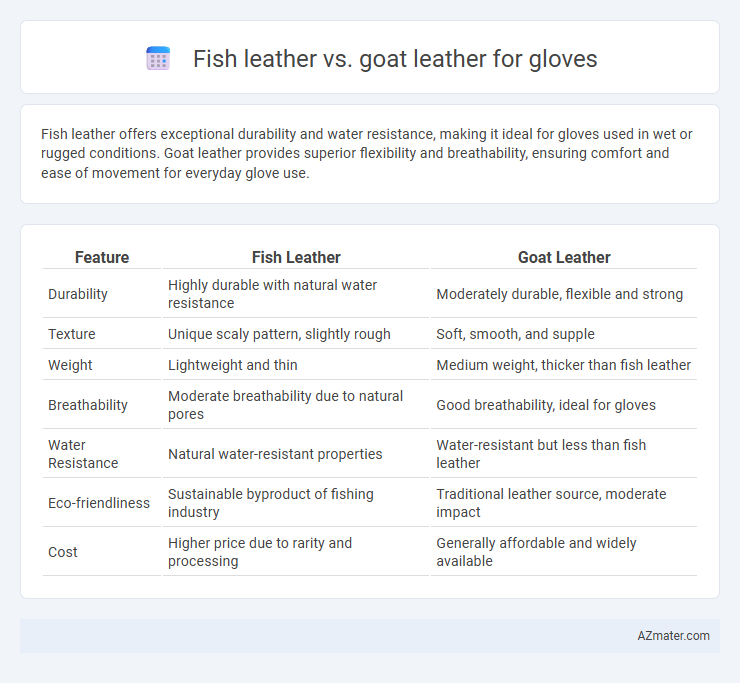Fish leather offers exceptional durability and water resistance, making it ideal for gloves used in wet or rugged conditions. Goat leather provides superior flexibility and breathability, ensuring comfort and ease of movement for everyday glove use.
Table of Comparison
| Feature | Fish Leather | Goat Leather |
|---|---|---|
| Durability | Highly durable with natural water resistance | Moderately durable, flexible and strong |
| Texture | Unique scaly pattern, slightly rough | Soft, smooth, and supple |
| Weight | Lightweight and thin | Medium weight, thicker than fish leather |
| Breathability | Moderate breathability due to natural pores | Good breathability, ideal for gloves |
| Water Resistance | Natural water-resistant properties | Water-resistant but less than fish leather |
| Eco-friendliness | Sustainable byproduct of fishing industry | Traditional leather source, moderate impact |
| Cost | Higher price due to rarity and processing | Generally affordable and widely available |
Introduction: The Glove Material Dilemma
Fish leather offers exceptional durability and water resistance, making it ideal for gloves exposed to wet conditions, while goat leather is prized for its softness, flexibility, and breathability, enhancing comfort and dexterity. Fish leather's unique scale patterns provide a distinctive texture and aesthetic appeal, contrasting with goat leather's smooth, fine grain. Choosing between fish and goat leather for gloves depends on balancing the need for toughness and moisture protection against the desire for supple fit and natural ventilation.
Overview of Fish Leather
Fish leather, known for its unique texture and durability, offers an eco-friendly alternative to traditional materials like goat leather for glove manufacturing. Derived primarily from species such as salmon, perch, and cod, fish leather features a distinct scale pattern that enhances grip and aesthetic appeal. Its natural water resistance and flexibility make it particularly suitable for gloves requiring both strength and comfort.
Overview of Goat Leather
Goat leather, renowned for its natural softness, durability, and breathability, serves as a popular choice for glove manufacturing due to its excellent flexibility and resistance to wear. It offers superior dexterity compared to fish leather, making it ideal for gloves requiring precision and comfort. The fine grain and lightweight properties of goat leather contribute to enhanced grip and prolonged usage without compromising hand mobility.
Sustainability and Environmental Impact
Fish leather offers a highly sustainable alternative to traditional goat leather due to its use of byproducts from the fishing industry, reducing waste and minimizing environmental impact. The tanning process for fish leather typically requires fewer chemicals and less water compared to goat leather, leading to a smaller ecological footprint. Goat leather production involves raising livestock, which contributes to deforestation, methane emissions, and significant water consumption, making fish leather a more eco-friendly choice for gloves.
Durability and Strength Comparison
Fish leather exhibits exceptional durability and tensile strength due to its unique collagen fiber structure, often surpassing goat leather in resistance to wear and tear. Goat leather is known for its flexibility and moderate strength, but it tends to be less resistant to abrasion compared to fish leather. For gloves requiring high durability and strength, fish leather offers superior performance, making it ideal for heavy-duty or long-lasting use.
Comfort and Flexibility
Fish leather, particularly from species like salmon and perch, offers superior softness and natural elasticity, making gloves exceptionally comfortable and flexible. Goat leather is renowned for its durability and breathability but tends to be stiffer, requiring more break-in time to achieve optimal comfort and flexibility in gloves. The unique collagen fiber structure in fish leather enhances glove fit and dexterity, providing a lightweight and supple alternative to traditional goat leather.
Aesthetic Qualities and Texture
Fish leather offers a unique, scale-patterned texture that provides a striking, natural aesthetic with a smooth yet slightly embossed feel, often preferred for its exotic look in luxury gloves. Goat leather delivers a soft, supple texture with fine grain, creating a matte or slightly glossy finish that emphasizes elegance and durability. The choice between fish leather and goat leather for gloves hinges on whether distinct visual appeal or refined softness is prioritized.
Cost and Market Availability
Fish leather gloves generally cost more due to the intricate processing required and their limited production scale, making them less commonly available in the market. Goat leather gloves offer a more affordable option with widespread availability, benefiting from established tanning processes and extensive supplier networks. Market demand and supply dynamics favor goat leather, while fish leather remains a niche product with premium pricing.
Best Uses: Which Glove for Which Purpose?
Fish leather offers exceptional water resistance and flexibility, making it ideal for gloves used in wet environments or fishing activities, while goat leather provides superior durability and breathability, perfect for work gloves and everyday wear. Fish leather's unique texture enhances grip and aesthetic appeal in fashion gloves, whereas goat leather excels in protection and comfort for tasks requiring dexterity and extended use. Choosing between the two depends on the glove's intended purpose: opt for fish leather for moisture-heavy conditions and goat leather for rugged, all-purpose performance.
Conclusion: Choosing the Right Leather for Gloves
Fish leather offers superior water resistance and unique texture ideal for stylish, durable gloves, while goat leather provides exceptional softness, flexibility, and breathability suited for everyday wear. Selection depends on the priority of glove use--fish leather excels in rugged, moisture-prone environments, whereas goat leather is preferred for comfort and dexterity. Assessing specific needs like durability, texture, and comfort ensures the best leather choice for gloves.

Infographic: Fish leather vs Goat leather for Glove
 azmater.com
azmater.com